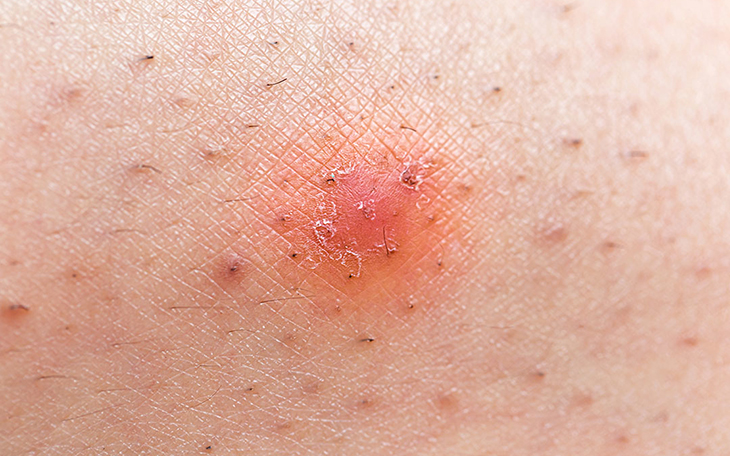
An ingrown hair can develop when a hair grows sideways into the skin after tweezing, shaving, or waxing. In rare cases, an infected ingrown hair can become life-threatening. Discover how to prevent this from happening to you.
Important Points to Note
- A 36-year-old man from Texas was hospitalized due to a rare bacterial infection possibly caused by an infected ingrown hair. At one stage, he was declared brain dead with only a 4 percent chance of survival.
- Infection of an ingrown hair can occur due to bacteria present on hands or tweezers.
- To safely remove an ingrown hair, opt for gentle exfoliation or use a sterile needle.
- If you notice pus, discoloration, or experience pain, it’s crucial to seek medical attention promptly.
A circulating narrative on social media sheds light on how what appears to be a minor health concern—such as an infected ingrown hair—can, in rare instances, escalate into serious and even life-threatening situations.
One such case, as shared on TikTok and reported by various media outlets, involves Steven Spinale, a 36-year-old resident of Texas. In October 2022, Spinale found himself hospitalized when a rare bacterium invaded his bloodstream, triggering organ failure.
Spinale and his family believed the infection originated from his attempt to remove an ingrown hair in his groin region. An ingrown hair occurs when a strand of hair grows back into the skin, often occurring after shaving, tweezing, or waxing.
Upon admission to the hospital, Spinale contracted the flu and developed double pneumonia. His blood infection advanced to the point where Spinale entered into septic shock.
Septic shock is a critical complication of sepsis, a severe immune response to infection that results in the immune system attacking the body’s own tissues, causing widespread inflammation.
“He declined fast until he crashed and was put on life support,” Spinale’s sister, Michelle, had written on a GoFundMe page that talked about his entire ordeal.
At a certain juncture, Spinale was pronounced brain dead, with only a 4 percent chance of survival. As the infection progressed to his heart, he was placed in a medically induced coma and underwent open heart surgery.
After three weeks, Spinale started to show signs of improvement. By the end of November, he was sitting up and smiling in his hospital bed.
However, the path to recovery has been gradual. In a social media update a year later, in the autumn of 2023, Spinale was still undergoing physical therapy, working on regaining the strength to move independently with the aid of a walker.
From Infected Hair Lead to Serious Infection
While Spinale’s situation is remarkably uncommon, Spencer Hawkins, MD, a dermatologist at Advanced Dermatology and Cosmetic Surgery in East Greenwich, Rhode Island, and the editor of HairMedicine.org, cautions that neglecting treatment for an ingrown hair can lead to worrisome complications.
“If bacteria spreads beneath the skin or into the bloodstream, it can lead to more serious infections like cellulitis or, in very rare cases, sepsis,” Dr. Hawkins said. “People with weakened immune systems or underlying health conditions are at a higher risk of complications.”
Although an infection can stem directly from an ingrown hair, bacteria present on hands, tweezers, or other tools utilized for hair removal can also be a contributing factor.
“When an ingrown hair enters the skin, the body’s immune system views the hair as a foreign substance, like a virus or bacteria, since it’s not in a hair follicle,” James Pathoulas, MD, a resident physician in dermatology at Stanford Medicine in California, also shared. “This triggers inflammation and skin breakdown, giving bacteria an opportunity to break through the skin barrier and cause infection.”
Whenever a bacterial infection occurs in the body, there’s a possibility that the bacteria can enter the bloodstream and spread throughout, potentially leading to sepsis.
How Infected Ingrown Hair Looks and Solution
An ingrown hair that’s infected usually looks like a swollen bump on the skin, similar to a pimple. It might contain pus and can be sensitive or painful when touched.
“The area around it can be inflamed and might feel warm,” said Hawkins.
To safely address an ingrown hair, the Cleveland Clinic advises a gentle exfoliation method to eliminate dead skin and free the trapped hair. Start by cleansing the affected area with warm (not hot) water and use small, circular motions with a washcloth, exfoliating brush, or an exfoliating gel or scrub.
If ingrown hairs are visible, you can release them by carefully inserting a sterile needle under each loop of hair and gently lifting the tip that has grown back into the skin.
Most ingrown hairs will resolve on their own within one to two weeks. However, if you notice pus, skin discoloration, or experience pain, it’s important to seek medical attention. If the pain intensifies, the infection seems to be spreading, or if you develop a fever, seek immediate medical help.
In certain cases, antibiotics may be prescribed by a doctor to help halt the spread of infection, according to Dr. Pathoulas.
Prevention of Ingrown Hairs
To prevent ingrown hairs and potential complications, Hawkins suggests the following:
- Use proper shaving techniques: Employ a sharp, clean razor and shaving cream or gel, and shave in the direction of hair growth.
- Regularly exfoliate to remove dead skin cells that might trap hairs.
- Keep skin moisturized to preserve its barrier function.
- Avoid tight clothing that can irritate the skin and hair follicles.
- Consider alternative hair removal methods like laser hair removal, especially if you’re prone to ingrown hairs and infections.
- Use a benzoyl peroxide or hypochlorous acid wash consistently to reduce bacteria on the skin.
If you find yourself dealing with recurring ingrown hairs or frequent and severe infections, it’s advisable to seek advice or treatment from a dermatologist. They can provide personalized guidance and suggest treatment options tailored to your specific situation.
As Michelle Spinale emphasized on TikTok, it’s crucial to be extremely vigilant about infections. This means paying close attention to any signs of infection and taking prompt action to address them.
“Infections can happen at any time and become deadly,” she said.



